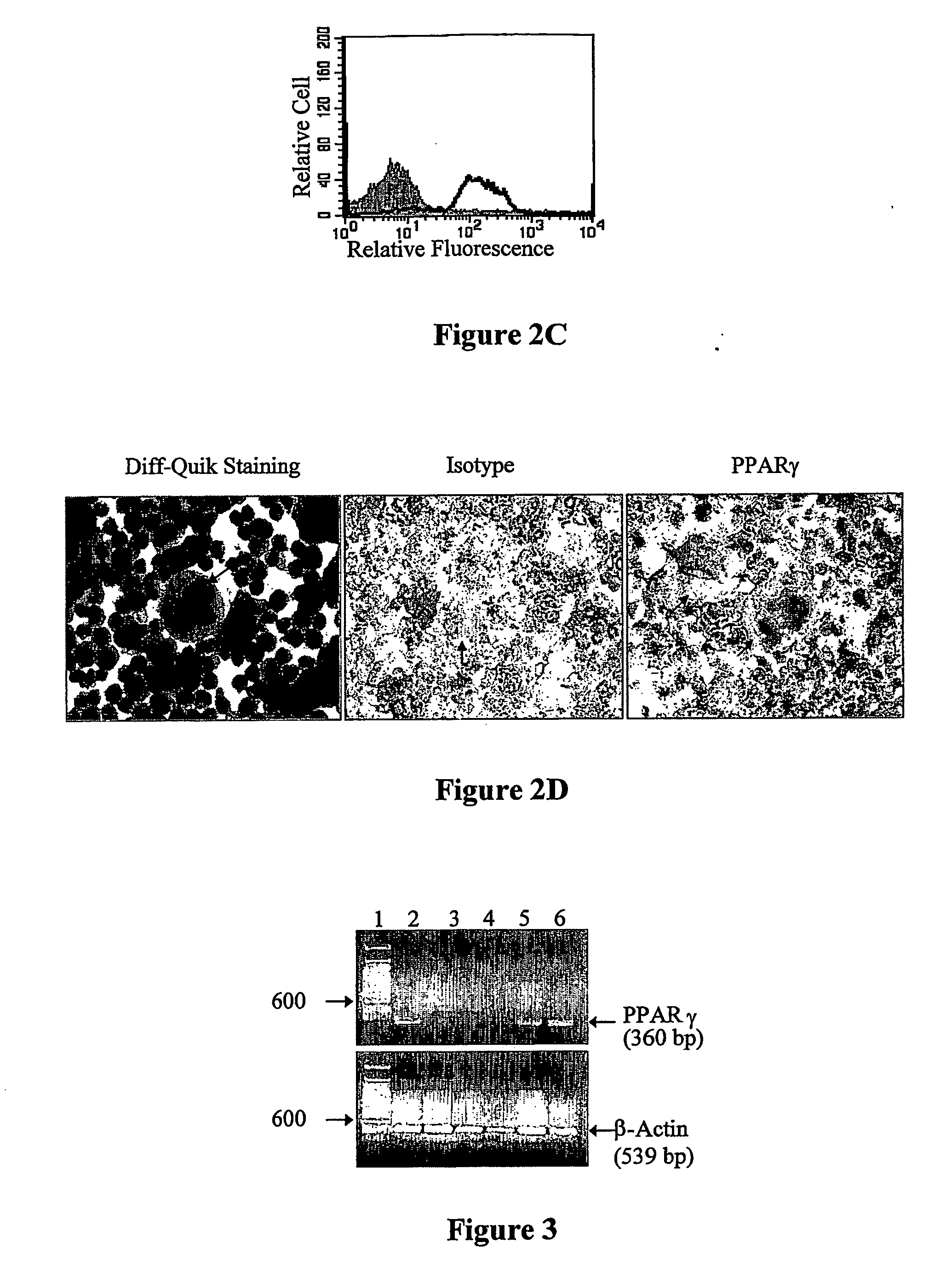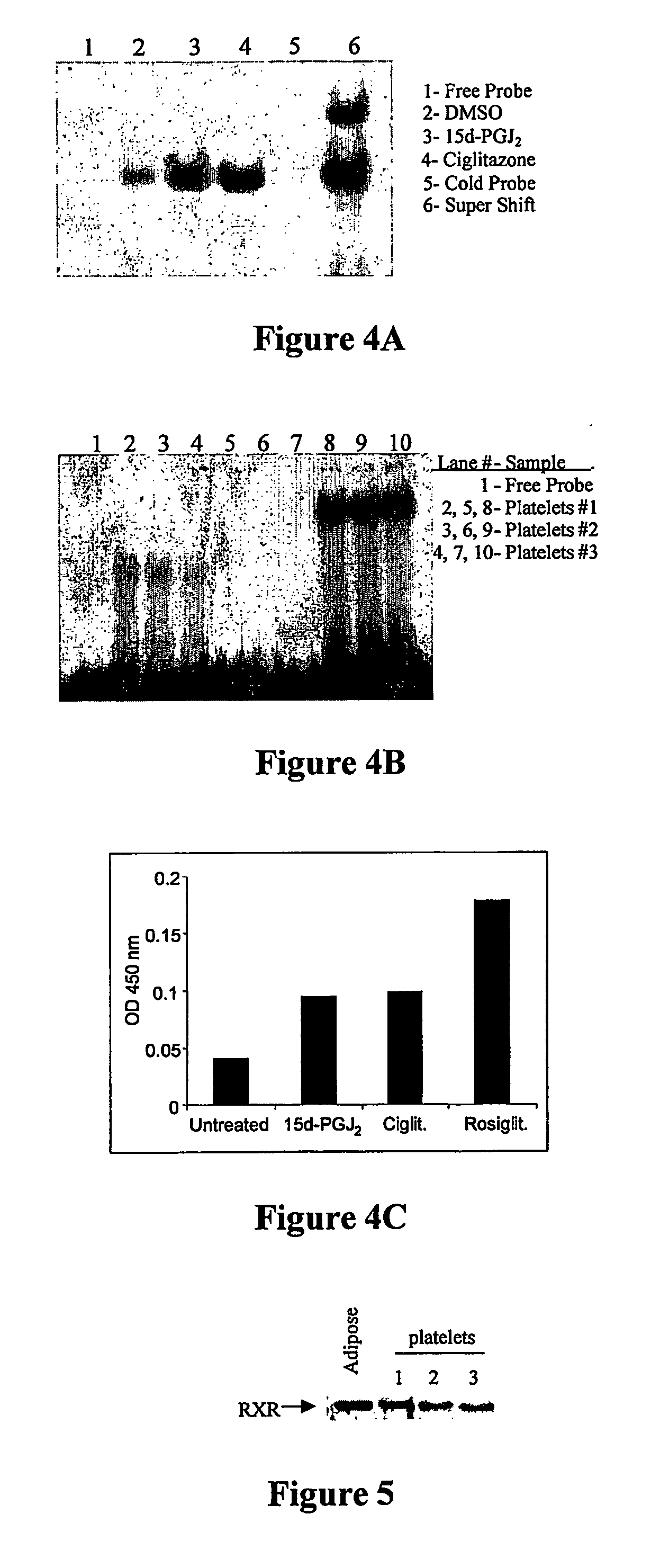Use of peroxisome proliferator-activated receptor gamma (ppary) and/or retinoic acid receptor (rxr) agonists to inhibit platelet functions
a technology of retinoic acid receptor and proliferator, which is applied in the direction of biocide, peptide/protein ingredient, and active ingredients of flavonoids, can solve the problems of inability to provide direct information about plaque disruption, cumbersome measurement, and increased risk of death or myocardial infarction, so as to inhibit platelet aggregation, effectively control the level, and blunt the release of cd40 ligand
- Summary
- Abstract
- Description
- Claims
- Application Information
AI Technical Summary
Benefits of technology
Problems solved by technology
Method used
Image
Examples
example 1
Meg-01 Megakaryocytes and Human Blood Platelets Express PPARγ Protein
[0106] Meg-01 cells have been extensively used as a model of human megakaryocytes (Ogura et al., “Establishment of a Novel Human Megakaryoblastic Leukemia Cell Line, MEG-01, with Positive Philadelphia Chromosome,”Blood 66:1384-1392 (1985), which is hereby incorporated by reference in its entirety). To determine whether megakaryocytes and platelets express PPARγ protein, Meg-01 cells and human platelets were tested by western blot for PPARγ. Meg-01 cells and platelets were lysed and the protein analyzed for PPARγ by western blot using commercially available and widely used anti-PPARγ antibodies. Meg-01 cells express PPARγ protein that co-migrated with human fat tissue PPARγ, used as a known positive control (FIG. 1A). We next evaluated highly purified human platelets for PPARγ expression. Three different single donor platelets and three multiple donor pooled platelet samples were tested for PPARγ using two differen...
example 2
Human Bone Marrow Megakaryocytes Express PPARγ Protein
[0110] Based on the fact that platelets and the Meg-01 cells expressed PPARγ protein, it was expected that human megakaryocytes would also express PPARγ protein. Expression of PPARγ in human bone marrow megakaryocytes was detected by immunocytochemistry using a monoclonal anti-PPARγ antibody. Human bone marrow was stained with Diff-Quik to identify human megakaryocytes (FIG. 2D). The megakaryocyte is the largest cell of bone marrow with multi-lobated nuclei and abundant granular cytoplasm. B one marrow smears were also prepared for immunocytochemistry to stain for PPARγ. The right-hand panel of FIG. 2D shows staining of human megakaryocytes for PPARγ. The middle panel shows no staining with an isotype control antibody (smear is lightly counterstained with hematoxylin).
example 3
PPARγ mRNA is Expressed in the Meg-01 Cell Line but not in Platelets
[0111] Expression of PPARγ mRNA in Meg-01 and platelets was examined by RT-PCR. Platelets, while enucleate, do express a range of mRNA species (Gnatenko et al., “Transcript Profiling of Human Platelets Using Microarray and Serial Analysis of Gene Expression,”Blood 101:2285-2293 (2003), which is hereby incorporated by reference in its entirety). Total RNA was isolated from Meg-01 cells and single donor or pooled platelets, and then reverse transcribed as described in the Materials and Methods section. Resulting cDNA was run in PCR reactions with control β-actin primers or primers specific for human PPARγ. RNA from human adipose tissue and THP1 human monocyte cells was used as positive controls for PPARγ. The results revealed a single RT-PCR product of the expected size of 360 bp for PPARγ in adipose tissue (FIG. 3, lane 2 ). Meg-01 cells and the THP-1 monocytic cells express PPARγ mRNA (FIG. 3, lanes 6 and 7, respec...
PUM
| Property | Measurement | Unit |
|---|---|---|
| Aggregation | aaaaa | aaaaa |
Abstract
Description
Claims
Application Information
 Login to View More
Login to View More - R&D
- Intellectual Property
- Life Sciences
- Materials
- Tech Scout
- Unparalleled Data Quality
- Higher Quality Content
- 60% Fewer Hallucinations
Browse by: Latest US Patents, China's latest patents, Technical Efficacy Thesaurus, Application Domain, Technology Topic, Popular Technical Reports.
© 2025 PatSnap. All rights reserved.Legal|Privacy policy|Modern Slavery Act Transparency Statement|Sitemap|About US| Contact US: help@patsnap.com



